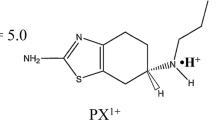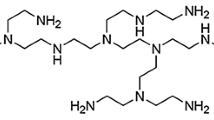Abstract
This study deals with effects of electrical (current density, frequency and duty cycle) and chemical (buffer pH and ionic strength) conditions on the flux of the octapeptide, 9-desglycinamide, 8-arginine-vasopressin (DGAVP), through dermatomed human skin. A pulsed constant current was applied during iontophoresis. The anode faced the anatomical surface of the skin samples inside the diffusion cells. The resistive and capacitative components of the equivalent electrical circuit of human skin could be calculated by fitting the voltage response to a bi-exponential equation. The skin resistance prior to iontophoresis varied between 20 and 60 k Ω.cm2. During iontophoresis a decrease of skin resistance and an increase of the series capacitances was observed, which were most pronounced during the first hour of iontophoresis; thereafter both quantities gradually levelled off to an apparent steady state value. The reduction of the resistance during iontophoresis increased non-linearly with increasing current density between 0.013–0.64 mA.cm−2. The steady state resistance and capacitances did not vary significantly with frequency and duty cycle of the current pulse. There was no pH dependence of skin resistance at steady state. Between pH 4 and 10, the steady state peptide flux had a bell-shaped pH-dependence with a maximum of 0.17 nmol.cm−2.h−1 at pH 7.4, which is close to the I.E.P. of the peptide. Lowering the ionic strength from 0.15 to 0.015 M NaCl increased the steady state flux at pH 5 and pH 8 by a factor 5 to 0.28 ± 0.21 and 0.48 ± 0.37 nmol.cm−2.h−1, respectively. Together these observations suggested that DGAVP is transported predominately by volume flow. At pH 6, at which 65% of the peptide carried a net single positive charge, the steady state flux increased with increasing current density (0.013–0.64 mA.cm−2) from 0.11 ± 0.03 to 0.19 ± 0.04 nmol.cm−2.h−1. Skin permeability during passive diffusion preceding iontophoresis at pH 6.0 was 2.9 ± 0.6 * 10−7 cm.h−7. In accordance with theoretical predictions based on the Nernst-Planck equation, to which a volume flow term was added, the flux was proportional to the mean voltage across the skin between 0.013 and 0.32 mA.cm−2.h−1. Variation of frequency or duty cycle did not result in significantly different peptide transport rates. From these studies it is concluded that DGAVP can be transported iontophoretically through human skin. The pH- and ionic strength-dependence of the iontophoretic peptide flux suggests that transport of DGAVP mainly occurs by volume flow. Furthermore, the flux of DGAVP appears to be controlled by the applied voltage rather than by the current density, as predicted by the Nernst-Planck equation.
Similar content being viewed by others
REFERENCES
Chien, Y. W., Siddiqui, O., Sun, Y., Shi, W. M., and Liu, J. C. Transdermal iontophoretic delivery of Therapeutic peptides/proteins. I: Insulin. Ann N. Y. Acad. Sci., 507:32–50 (1987).
Burnette, R. R.. Iontophoresis. In Hadgraft, J. and Guy, R. (Eds.), Transdermal Drug Delivery. Marcel Dekker, Inc., New York, 35:247–288 (1989).
Phipps, J. B., Padmanabhan, R. V. and Lattin, G. A. Transport of ionic species through skin. Solid State Ionics, 28–30:1178–1783 (1988).
Pikal, M. J. Transport mechanisms in iontophoresis. III. An experimental study of the contributions of electroosmotic flow and permeability change in transport of low and high molecular weight solutes Pharm. Res. 7:222–229 (1990).
Srinivasan, V. and Higuchi, W. I. A model for iontophoresis incorporating the effect of convective solvent flow. Int. J. Pharm., 60:133–138 (1990).
Laczi, F., Van Ree, J. M., Wagner, A. Valkusz, Zs., Jardanhazy, T., Kovacs, G. L., Telegdy, G., Szilard, J., Laszlo, F. A. and De Wied, D. Effects of des-glycinamide-arginine-vasopressin (DGAVP) on memory processes in diabetes insipidus patients and non-diabetic subjects. Acta Endocrinologica, 102:205–212 (1983).
Verhoef, J. Van den Wildenberg, H. M. and Van Nispen, J. W. [3H]9-desglycinamide, 8-argine vasopressin: metabolism and invivo fate. J. Endocr. 110:557–562 (1986).
Van Bree, J. B. M. M., De Boer, A. G., Danhof, M., Verhoef, J. C., Van Wimersma Greidanus, T. B., Breimer, D. D. (1988) Radioimmunoassay of desglycinamide arginine vasopressin and its application in a pharmacokinetic study in the rat. Peptides, 9:555–559 (1988).
Kasting, G. B. Application of electrodiffusion theory for a homogeneous membrane to iontophoretic transport through skin. J. Control. Rel., 8:195–210 (1989).
Lakshminarayanaiah, N. Equations of Membrane Biophysics. Academic Press, New York, 39 (1984).
Sims, S. M., Higuchi, W. I. and Srinivasan, V. Skin alteration and convective solvent flow effects during iontophoresis. I. Neutral solute transport across human skin. Int. J. Pharm., 69:109–121 (1990).
Pikal, M. J. The role of electroosmotic flow in transdermal iontophoresis. (1992) Advanced Drug Delivery Review, 9:201–237 (1992).
Author information
Authors and Affiliations
Rights and permissions
About this article
Cite this article
Craane-van Hinsberg, W.H.M., Bax, L., Flinterman, N.H.M. et al. Iontophoresis of a Model Peptide Across Human Skin in Vitro: Effects of Iontophoresis Protocol, pH, and Ionic Strength on Peptide Flux and Skin Impedance. Pharm Res 11, 1296–1300 (1994). https://doi.org/10.1023/A:1018994428375
Issue Date:
DOI: https://doi.org/10.1023/A:1018994428375




